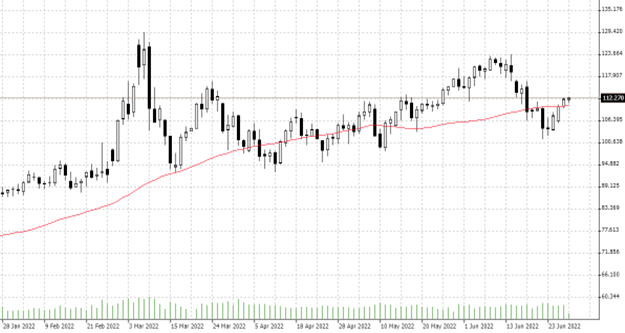

29.06.2022 – Turmoil in the oil market: Unrest in some smaller producing countries. Discussions about the exclusion of Russia from OPEC+. And most importantly, major producers Saudi Arabia and the United Arab Emirates appear to be at their maximum production capacity.
The bullish factors currently prevail in the oil market, as you will read below in a moment. Oilprice.com even sees a possible “doomsday” scenario for the market in the short term. In any case, the West Texas Intermediate (WTI) grade is groping its way up nicely along the 50-day trend.

Source: Bernstein Bank GmbH
Initially, Libya caused headaches for the bulls. The shattered country had initially recently announced that oil production was recovering. However, the state-owned National Oil Corporation (NOC) just warned of a possible force majeure that could release the company from fulfilling affected contractual obligations. In addition, unrest is raging in Ecuador – half of its production has already been lost, and soon it could be all of it. Libya and Ecuador together produce about 2 million barrels a day. In addition, exporters like Iraq are notoriously unstable.
At the limit
However, the news from Saudi Arabia and the Emirates is particularly problematic. Until now, both producers were considered important gap fillers to compensate for Russian oil in the wake of the Ukraine invasion. Russia’s shortfall is estimated to take 4.4 million barrels per day off the world market. The Emiratis officially said they are very close to their quota of about 3.2 million barrels per day allowed by OPEC. Moreover, they said, there are hardly any reserves in the short term. Saudi Arabia, meanwhile, said it can still produce up to an additional 2 million barrels per day in the short term.
Bad news
However, Oilprice.com reported that French President Emmanuel Macron told U.S. President Joe Biden at the G7 summit that the Saudis could only throw 150,000 barrels of reserve onto the market and that the Emirates was already at its limit. This, he said, was what the Emirates’ president, Mohammed bin Zayed, told him. Analyst Tobin Gorey of Commonwealth Bank confirmed this, pointing out that the UAE and Saudi Arabia were indeed producing at the end of their capacity.
Our conclusion: there is currently little argument for a reset in the oil market. Production is not likely to be ramped up significantly. Meanwhile, shale production in the U.S. is frozen for political reasons, eco and all. At the same time, the economy is ramping up again after the Corona shock, and tourism is picking up rapidly as people rush to take vacations before our gifted rulers impose another lockdown. Whether consumers are saving enough to cause a collapse in demand is doubtful. At best, a recession could ensure that. Goldman Sachs, by the way, raised its price target for Q3 22 from $119 to $139 per barrel of WTI earlier this month.
However, there could be surprises from the current OPEC meetings – today is the 184th Meeting of the OPEC Conference, tomorrow the 30th OPEC and non-OPEC Ministerial Meeting. Therefore, keep an eye on the real-time news. Bernstein Bank wishes you successful trades and investments!
Important Notes on This Publication:
The content of this publication is for general information purposes only. In this context, it is neither an individual investment recommendation or advice nor an offer to purchase or sell securities or other financial products. The content in question and all the information contained therein do not in any way replace individual investor- or investment-oriented advice. No reliable forecast or indication for the future is possible with respect to any presentation or information on the present or past performance of the relevant underlying assets. All information and data presented in this publication are based on reliable sources. However, Bernstein Bank does not guarantee that the information and data contained in this publication is up-to-date, correct and complete. Securities traded on the financial markets are subject to price fluctuations. A contract for difference (CFD) is also a financial instrument with leverage effect. Against this backdrop, CFD trading involves a high risk up to the point of total loss and may not be suitable for all investors. Therefore, make sure that you have fully understood all the correlating risks. If necessary, ask for independent advice. CFDs are complex instruments and are associated with the high risk of losing money quickly because of the leverage effect. 68% of retail investor accounts lose money trading CFD with this provider. You should consider whether you understand how CFD work and whether you can afford to take the high risk of losing your money.7
